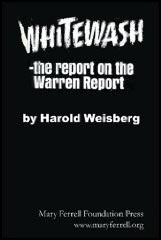March 25, 2012
WHITEWASH-the report on the Warren Report by Harold Weisberg, Chapter 5: At The Depository - The Tangible Evidence I
Knoxville, Tennessee (JFKASSASSINATION) Today this blog begins a report on Chapter 5 of Harold Weisberg's book "Whitewash--the report on the Warren Report", published in 1965.
The title of Chapter 5 is At The Depository -- The Tangible Evidence
Harold Weisberg begins this chapter with a description of the shooting upon the Presidential motorcade in Dallas, Texas at about 12:30 p.m. November 22, 1963.
Mr. Weisberg writes:
"The President received a wound below the larynx & a massive head wound (which resulted in the loss of) much of the right side of his head."
Mr. Weisberg also describes the wounds suffered by Governor John Connally.
He further states that most of the central facts "are among the few that are not subject to question, doubt or disbelief."
But Mr. Weisberg believes that the Warren Commission investigation at the Texas School Book Depository "was highly dubious (in) character."
Harold Weisberg reminds his readers that the crime was committed in the presence of a multitude of police eyewitnesses, including Secret Service agents & sheriff's deputies & further that despite the fact that the building was almost immediately identified as the source of shots, it was "never sealed off--not ever."
Weisberg further states that "there was no organized search of the building, either immediately or as an afterthought."
He points out that the empty rifle shell casings in the Depository's 6th floor corner window were not found by police until 42 minutes after the shooting & the rifle itself was not found until 10 minutes after that.
Added to these facts, Mr. Weisberg says that with the shooter apparently still in the building, no attempt was made to secure the exits & a description of the suspect was not announced over the police radio for another 15 minutes.
Harold Weisberg calls these happenings "blunders" that became a "persistent pattern of the entire police operation."

No comments:
Post a Comment